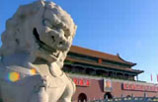Lifeline made of iron
Updated: 2015-02-13 08:52
By Joseph Catanzaro, Hu Haiyan and Li Yu(China Daily Europe)
|
|||||||||||
As new railway lines are laid all across China, one region is reveling in the benefits
The train is coming. That's all anyone is talking about on the southern outskirts of Xinjin county in Sichuan province. From the hole-in-the-wall eatery she has run for 20 years, it takes Li Xi a few minutes to walk over to where the brand new railway station stands silent and waiting. The 50-year-old local has watched the high-speed line between Chengdu, the provincial capital, and Mianyang stretch inch by inch, slowly cutting through fields of crops and clusters of crumbling peasant homes.
In March, trains will run over this virgin route and stop here for the first time.

|
A train arrives at a station in Sichuan province. The expanding rail network in the west is joining the hitherto disparate dots between foreign investors, cheap land, affordable labor and domestic and international markets, experts say. Provided to China Daily |

"It's coming," Li says. "I'm excited. Everyone is excited. There will be more employment here for my son and daughter, for my children's generation. They won't have to move away to the east to find work."
The same sense of expectation is spreading across the rest of western China, keeping pace with a growing rail network. In Sichuan province alone, 18 railway lines are being laid down, all of them passing through Chengdu.
Locals in isolated areas like Li have watched the advancing lines of steel and concrete being thrown out every which way like economic lifelines.
The train is coming, and in western China many believe it heralds the dawn of a business boom.
Over the past 30 years, while eastern China with its ready ports became a manufacturing powerhouse and magnet for foreign investment, landlocked and logistically isolated western China was largely left behind.
But all that is about to change, says Chi Fulin, president of the China Institute of Reform and Development, a think tank in Haikou, Hainan province.
Chi is among those who are convinced the expansion of the railway network in western China will give a huge economic fillip to the region. And new rail links between Europe and Asia mean the benefits will run in two directions.
With business overheads on China's eastern seaboard rising, Chi says, the expanding rail network in the west is joining the hitherto disparate dots between foreign investors, cheap land, affordable labor and domestic and international markets.
"The development of the railway network in western China, especially the international railways, will promote the region's opening to the outside world."
Last year the central government spent 809 billion yuan ($130 billion; 114 billion euros) building 8,427 kilometers of railway lines nationally. Like a modern replay of the coming of the railways to the old American west, many of the new lines run out into provinces like Sichuan, opening up undeveloped regions and towns for the first time.

On the other side of Xinjin county from Li's eatery, old men sit and smoke cigarettes out the front of roadside restaurants, watching the traffic go by with slow and silent regard.
Wang Kexin, 65, does not have the time to join them. Here in the northern part of the county, a new station on a different branch of the line opened a month ago, and her electronic components manufacturing business is doing very nicely.
Before the coming of the train, Wang says, it took seven days to transport goods by road to Guangdong, about 1,700 km to the south, where many of her domestic customers are. With the train it now takes one day.
The delivery time for her international exports has also improved dramatically.
Instead of a long trip by road to the ports of the east, followed by a lengthy voyage on a container ship, the product she makes for export is now taken to Chengdu by train and from there straight onto the new Chengdu-EU rail line. Instead of waiting about two months, her international customers can now expect delivery in 14 days. With the road component removed from the new logistics setup, she is in fact saving money.
"It's reducing the cost of logistics for our goods by more than 20 percent. And it's saving so much time. It's really helping our company grow."
And Wang says it is not just locals who have realized the potential.
"There are more people from the EU and the US here now. In fact a company from Hungary invested in my company recently. We are now sending about 50 tons of small components to Europe on the Chengdu-to-Poland train. The railways mean it's western China's turn to be developed."
About one hour's travel down the new high speed line from Xinjin county, on the northern outskirts of Sichuan's capital, Chengdu, containers of computers and car parts are packed and stacked and made ready for the departure of the weekly train to Poland.
In operation since 2013, the train snakes up through central Asia and into Lodz, connecting western China with Europe in a latter-day ferrous version of the ancient Silk Road trade route.
Chen Zhongwei, director of Chengdu's Logistics Department, says the positive economic impact of the new railways, particularly those linking western China to the outside world, are beginning to be felt.
"Before Chengdu was an inland city, moving goods was not only very inefficient, but also expensive," he says.
"Now because of the trains, from (the coastal city of) Xiamen in the southeast, it only takes goods two days to get here; it only takes goods one day to get from Taiwan to Xiamen; and it only takes 13 days for goods to get to Poland from here. So it's 16 days from Taiwan to Europe. To ship the same goods by water, it takes about two months."
There are 262 Fortune 500 companies with a presence in Chengdu, and the local statistics bureau says foreign investment in the city hit $10 billion last year.
The city's GDP recently surpassed 1 trillion yuan, 8.9 percent higher than in 2013. Foreign trade was worth 55.9 billion yuan, 10.4 percent higher than in 2013.
"Because of the railway to Europe, trade between it and Chengdu has greatly improved, as has the investment environment here for European and Chinese companies," Chen says.
For local worker Zhang Changjiu the practical effect of that is a doubling of his pay and more employment opportunities.
Standing on the loading docks of a warehouse in Qingbaijiang, close to where the EU railway begins, the 44-year-old points at a six-story complex of modern buildings nearby.
"That's where my family's farm used to be," he says.
When the line was laid, industry came with it, and for Zhang the rhythm of life on the land gave way to the rhythm of the rails.
His small patch of crops and his family's thatched roof home were demolished to make way for new infrastructure. In exchange, the government gave him two new apartments, and he got a job loading goods for a logistics company that specializes in rail freight.
"I used to make 1,000 yuan to 2,000 yuan a month farming," he says. "It was hard work, and it was difficult to support my parents, sister, wife and child on that money."
Zhang's wage now is about 3,000 yuan to 4,000 yuan a month, still relatively low by east coast standards, but more than sufficient in western China, he says.
"For me, life is much better now. I can easily afford to buy meat and baijiu (white spirits). My family's life is a lot better, too."
Chen Jie is the general manager of logistics for Chengdu Hatrans YHV Intermodal Logistics, the company that operates the freight train between Chengdu and Lodz.
From a slow start in early 2013 the service is now picking up speed, he says. Since the train's maiden run it has done 76 trips. The total value of cargo carried is $573 million, and the total weight is 21,255 tons. About 76 percent of the train's capacity is used on average on each run.
"In peak seasons, we are full and there's no extra space," Chen says.
It is still early days, he says, and rail remains small fry compared with entrenched logistics options such as sea and air. But he is among those who strongly believe the potential is there, and says the train is already prompting new customers to set up shop in the region, or is allowing established businesses to expand their operations.
"The cost of rail sits between air and sea. It costs about $8,000 to transport each container (which holds about 25 tons) by rail from Chengdu to Europe. We are looking for customers who have a product that is time sensitive, but can't be too expensive to transport, customers who, if they use air, can make delivery on time, but not under cost, and if they use sea, they can make the delivery by cost, but not within time."
At the moment, Chen says, the train is primarily carrying completed and half-finished computers, cars, mechanical spare parts, textiles, shoes, kitchenware and home fittings.
However, the variety and nature of the cargo is constantly changing as foreign and domestic companies move their operations from the east coast to cheaper locations, he says.
"We've seen it already. Half of our customers were originally on the coast. And because of the lower cost of labor and utilities (in western China), there are many companies that are setting up in Sichuan - big names like Bosch. Western China will become the new growth point because of this train. Previously western China didn't have the access to do business."
Chen says that this year the train's frequency will increase from once a week to twice a week, or even possibly once a day.
Of greater interest to European exporters, he says, is the fact that this year the train will begin carrying cargo from Europe back to Chengdu to feed an appetite for imported goods that is increasing in line with western China's rising living standards.
In Chengdu alone, imports were worth $22 billion last year, an increase of 17.8 percent on the previous year. The value of exports rose 6.1 percent to $33.82 billion.
William Wu, owner of food distributor Mix Max Foodmall, is among those keenly awaiting the advent of the Europe-to-Chengdu train. The appetite for European luxury food products in Chengdu is already high, he says, and the compromise between delivery time and cost will make many new products viable for sale in western China for the first time.
"Western China's market has a huge need for food, wine, grain and so on 100,000 tons of food doesn't currently satisfy the Chengdu market for even one month, and about 10 percent of that is currently imports. That's not including the demand from the surrounding areas in Sichuan. There's huge market potential, and there's also potential to transport goods (from Europe and through Chengdu) on into the rest of China."
Inside the Chengdu high-tech bonded zone, Sagent Pharmaceuticals, a US company, is scrambling to triple its production capacity to meet growing market demand.
The company's vice-president in China, Shane Tian, says the decision to set up its China operations in Chengdu was made with an eye to the future.
"When we came to this park in 2006 it was empty and now it's almost full. Next door is a US company that makes computer chips. Across the road is Foxconn."
Last year, 20 percent of the world's computers and two-thirds of the world's iPads were made in Chengdu.
It makes sense that big names are flocking to China's west, Tian says.
"It would have been much more expensive for us to set up and operate on the east coast of China. The land is much cheaper here. The costs are lower to do business here. This is the center of new development and a great place to do business. It's stable, we have direct flights to San Francisco and Europe and the living cost is low. Young people here can actually afford to buy a home, and it helps us attract and retain talent. At the moment we sell our product in the US market. But eventually we will sell into China and the global market including Europe, and if you are exporting to Europe, here you actually have a (logistics) advantage now."
A recent announcement that a second major airport is to be built in Chengdu is also good news for western China, he says.
The new 69.3 billion yuan airport, due to be completed in 2025, will be able to handle 40 million passengers a year.
The company that runs the existing Shuangliu International Airport, Sichuan Province Airport Group, says the second airport is badly needed.
Xiao Yao, vice-manager of the company's marketing and investment department, says the current airport is the fifth busiest in China. Last year 37 million passengers passed through it, 12.8 percent more than in the previous year. About 3 million were international passengers, 31.9 percent higher than in 2013. More than 540,000 tons of freight passed through the airport last year, 9.2 percent higher than in 2013.
Xiao says the existing airport serves 78 international passenger and cargo routes, and once the new airport is completed he sees big potential for expansion, particularly when it comes to linking western China and Europe.
"Europe is very important to Chengdu," he says. "Chengdu is right on the central air route from Asia to Europe. Every day more than 50 flights from Asia fly over Chengdu. They don't stop at the moment, but they could in the future."
In the small village of Chengxiang, less than an hour's drive from the EU railway yard, Huang Zuoyu, 52, watches over her two young granddaughters at play. Ducks and geese in bamboo cages flap and honk. A mangy dog lies sleeping in the winter sun near a small plot of crops.
The trains, Huang says, have changed her family's life.
"There was a time when farming was our only income. We had only a tiny patch of land, and we had many people to feed. It was hard.
"My husband and my daughter's husband work in the town now. The railways have made it easier for them to find work. My granddaughters will go to college and find good jobs. At last they will have prospects."
Huang bounces her 1-year-old granddaughter on her lap. She shouts out affectionately to the baby's 5-year-old sister.
"What do you want to do when you grow up?"
The little girl, who is busy scraping dirt off the concrete with a trowel, screws up her tiny face in concentration.
"I think I'll just keep doing this," she says seriously.
The adults burst out laughing.
In this home, laughter and choice have not always been givens.
The train is coming, and it is bringing change with it.
Peng Chao contributed to this story.
Contact the writers through josephcatanzaro@chinadaily.com.cn
|
Clockwise from top left: Wang Kexin, a 65-year-old businesswoman in the county of Xinjin; Shane Tian, Sagent Pharmaceuticals' vice-president in China; Chen Zhongwei, director of Chengdu's Logistics Department; and Chen Jie, general manager of logistics for Chengdu Hatrans YHV Intermodal Logistics. Photos by Peng Chao / China Daily |
|
Huang Zuoyu and her two young granddaughters at Chengxiang village in Sichuan province. Hu Haiyan / China Daily |

(China Daily European Weekly 02/13/2015 page1)
Today's Top News
Ceasefire agreed for E.Ukraine
Russia's YotaPhone places big bet on China
EU leaders to urge stricter border checks in counter-terror drive
Leaders hold Ukraine peace talks as fighting surges
Costa Concordia captain sentenced to 16 years for 2012 shipwreck
Chinese investors shifting focus in global realty purchases
Greek PM easily wins confidence vote
Contact group on Ukraine reaches ceasefire deal
Hot Topics
Lunar probe , China growth forecasts, Emission rules get tougher, China seen through 'colored lens', International board,
Editor's Picks

|

|

|

|

|

|








